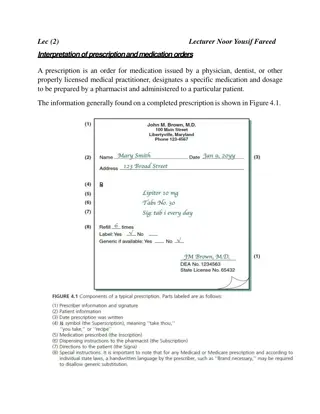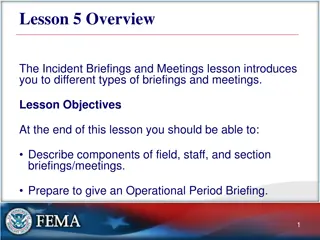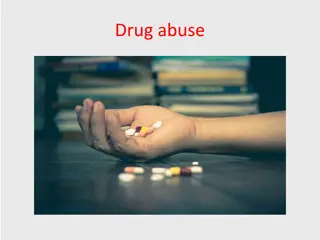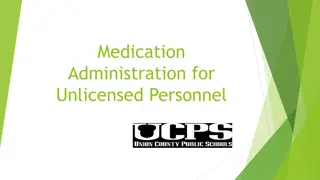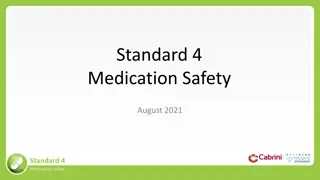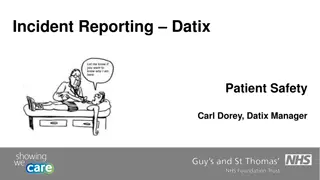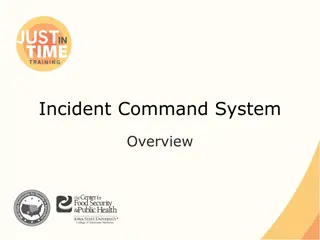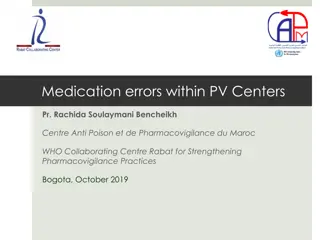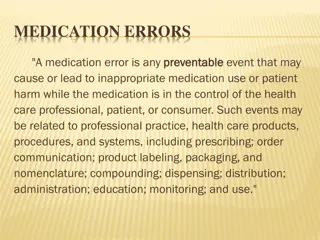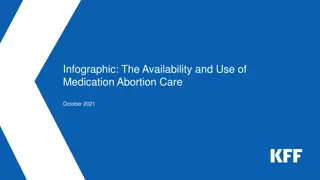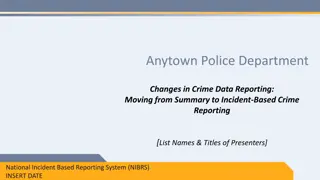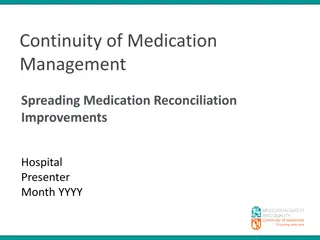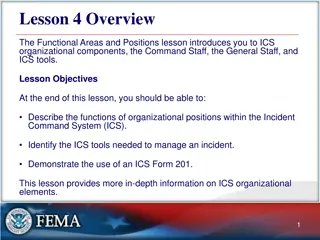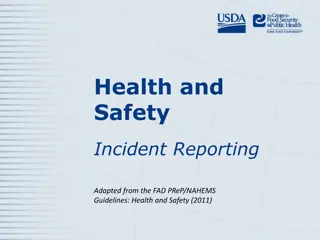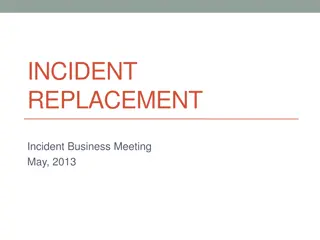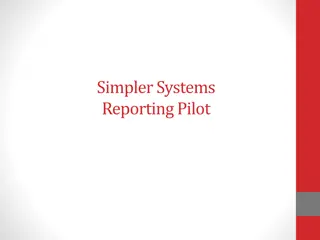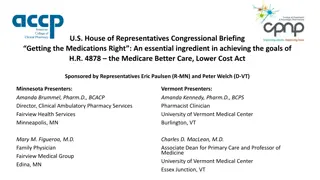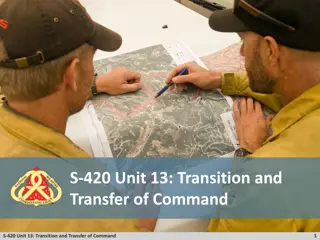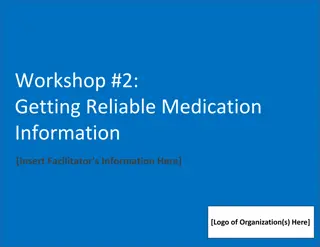Feedback Analysis on Medication Incident Reporting in Hospitals
Feedback received from IMSN members on NIMS and incident reporting revealed various issues affecting the rates at which staff report medication incidents/near misses within hospitals. Major themes included staffing numbers and turnover, pharmacist involvement in incident reporting, clinical pharmacy staffing levels, individual perceptions of reporting importance, variability in reporting rates among staff, lack of feedback for reporters, fears hindering reporting, barriers to reporting for doctors, and decreased reporting rates during certain periods. Suggestions for improvement included addressing staffing issues, enhancing feedback mechanisms, increasing awareness on reporting importance, and streamlining reporting processes across hospitals.
- Medication incidents
- Hospital feedback analysis
- Incident reporting
- Staffing levels
- Pharmacist involvement
Download Presentation

Please find below an Image/Link to download the presentation.
The content on the website is provided AS IS for your information and personal use only. It may not be sold, licensed, or shared on other websites without obtaining consent from the author. Download presentation by click this link. If you encounter any issues during the download, it is possible that the publisher has removed the file from their server.
E N D
Presentation Transcript
Feedback received from IMSN members on NIMS & Incident Reporting Oct-Nov 2023
Questions All IMSN members wererequested to feedback on the following questions: What are the issues affecting the rates at which staff report medication incidents/near misses within the hospital? The basic reporting What causes this to increase or decrease? E.g. Staffing levels and skillmix, pharmacy staffing, patient safety culture, rules, processes, history, whether interventions are reported as incidents etc. 1. Forms: Do you use NIMS/separate paper form/electronic form/EPOE for NIMS? What does the NIMS form facilitate, and what about the NIMS form is a barrier? What is/was good about the medication-specific form? 2. NIMS: Are there issues with reporting on NIMS other than data entry? E.g. Can t report a no patient near miss as a medication incident, no NCCMERP, no profession reporting, open disclosure yes/no 3. Data entry to NIMS: Is it direct entry/ entry by med safety/ entry by quality/risk management? What are the issues affecting the rates at which medication reports get entered to NIMS? E.g. rules within quality department, staffing 4. Incident management/analysis/reporting: Do you/can you use NIMS to manage reports, analyse trends etc? Do you use another system? What are the advantages and disadvantages of both? 5. What would be required in order for all hospitals (including model 2s and specialty) to achieve good medication reporting rates, i.e. 5 per 1,000 bed days? And for that to lead to improvement? E.g. Staffing, ease of reporting, culture, governance, responsive designated medication safety officer ? 6.
Feedback response rate Feedback was received from drug safety pharmacists in 10 hospitals: Midland Regional Hospital Tullamore 1. Beaumont Hospital, Dublin 2. St Francis Hospice Dublin 3. Letterkenny University Hospital 4. Sligo Hospital 5. Mullingar Hospital 6. Cork University Hospital 7. Limerick University Hospital 8. St Vincent s Private Hospital 9. Mater Misericordiae University Hospital, Dublin 10.
Summary of feedback Themes identified Question 1 What are the issues affecting the rates at which staff report medication incidents/near misses within the hospital? Staffing numbers and turnover Pharmacists report large majority of medication related incidents. Clinical pharmacy staffing levels Culture, Each individuals perception of the importance of reporting / judgment. Reporting is very variable with some staff being prolific reporters, others less so. Follow-up - people who report feel that they never get any feedback on what they have reported Fear may be a factor in the low level of reporting of harm events Staff may not know what type of incidents to prioritise or have visible feedback on who is reporting, rates and severity of patient outcome (NCC MERP) Time to report, Competing demands Time to fill in form Accessibility of PCs to complete the forms Barriers to doctors reporting may include time constraints, lack of feedback, fear of blame / litigation, usability of report forms, under appreciation of the value of reporting no harm errors, lack of awareness of responsibility for variance completion and concerns around information disclosure. Decreased reporting rates noted over COVID, Holiday periods Different reporting systems in different hospitals Concerns surrounding accountability in some cases Doctors request for Nursing staff to complete the report
Summary of feedback Themes identified in responses Question 2 Forms: Do you use NIMS/separate paper form/electronic form/EPOE for NIMS? What does the NIMS form facilitate, and what about the NIMS form is a barrier? What is/was good about the medication-specific form? 5/10 responders use NIMS form 5/10 responders used another method e.g. separate form, Q-Pulse, Datix Midland Regional Hospital Tullamore NIMS paper form + editable PDF Beaumont Hospital, Dublin separate form St Francis Hospice Dublin separate form Letterkenny NIMS system Sligo Hospital NIMS form Mullingar Hospital NIMS form Cork University Hospital NIMS form Limerick University Hospital Q-pulse system St Vincent s Private Hospital - Datix Mater MisericordiaeUniversity Hospital, Dublin separate form
Summary of feedback Themes identified Comments on NIMS Form Question 2 Continued You can only pick one category and two medicines - isn t always adequate. NCC MERP categorisation would be much more useful. Form doesn t also prompt for information required to categorise incidents using NCCMERP algorithm Limited space to describe the incident requires follow-up with reporter Near misses are reported as near miss if it related to a specific patient, otherwise a dangerous occurrence when it doesn't relate to specific patient. These are often errors, e.g. errors in drug storage or documentation issues. Dangerous occurrences don't have a section to choose the medication. The NIMS form, in trying to capture all types of incidents not just medications, therefore the drop down categories to select are not very obvious leading to category or subcategory miss selection. Form is off-putting for medication safety incidents long, most parts aren t relevant Form doesn t distinguish location where error occurred from location reporting it Description of incident and immediate actions taken sections are separated not ideal Need to have a patient s MRN to upload (otherwise classified as a dangerous occurrence) Form doesn t ask re contributing factors Too few options in step 4, plus the slashes aren t ideal e.g. wrong formulation / route (these aren t the same), wrong dose / strength (these aren t the same) Difficult to use Assessing the outcome can be difficult sometimes for the reporter at the time of reporting. The options included for the type of injury often don t suit medication incident outcomes. The options given for incident category (e.g. ADR, omitted dose etc) are quite limited, some additional options such as therapeutic duplication, allergy/intolerance, expired drug, incorrect storage, incorrect duration, incorrect rate of administration etc would be useful as often the options given don t appropriately describe the incident category.
Summary of feedback Themes identified in responses Question 2 Continued Comments on use of other methods of reporting medication incidents e.g. separate form, Datix, Q-Pulse Some hospitals use separate forms to capture more descriptive information about medication incidents. On Qpulse, although not a medication specific form, once medication selected from a drop down menu , further questions specific to medications appear. Datix - drop down menu, some staff feel it takes too long to fill out, needs to be filled out on a computer and there may not be one free. You need to fill it out in one sitting which can be difficult for busy staff who are interrupted. However it is very useful for trending and the instant results can be used for monthly reports to Quality. Other columns on the excel sheet / separate form that allow analysis / help to categorise errors. Content in separate forms reflect the NIMS form.
Summary of feedback Themes identified in responses Question 3 NIMS: Are there issues with reporting on NIMS other than data entry? E.g. Can t report a no patient near miss as a medication incident, no NCCMERP, no profession reporting, open disclosure yes/no Agree with above i.e. Can t report a no patient near miss as a medication incident, no NCCMERP, no profession reporting, open disclosure yes/no Only 2 medications can be recorded on one report- one hospital reported asking staff to use free text summary of incident section which will not be captured in the data( leading to under reporting) otherwise staff would be required to record multiple incident reports to record drugs involved. Pharmacist and pharmacy technician not a listed profession for the reporting person A near miss that did not reach the patient must be categorised as a dangerous occurrence. This has lead to these errors not being reported as the usual incident report can not be completed without patient details and this has caused staff to abandon the reporting as they were not aware of this dangerous occurrence reporting pathway. NCC MERP one hospital reported using the Witness section as a work around to document MERP categorization Using NIRF 4 to categorise any no patient near miss (e.g. expired stock sent to ward this would be categorised as NIRF 4 (Med Safety Policy breach) Open disclosure - often ticked as No if there is no harm user variability when in-putting incidents (sometimes an incident would be put in as a near miss when there is no harm to a patient but I would still class as an incident). Extravasation related incidents have a root cause relating to IV line management, sometimes not medication related - ? Best way to report these events
Summary of feedback Themes identified in responses Question 4 Data entry to NIMS: Is it direct entry/ entry by med safety/ entry by quality/risk management? What are the issues affecting the rates at which medication reports get entered to NIMS? E.g. rules within quality department, staffing Midland Regional Hospital Tullamore QPS Beaumont Hospital, Dublin pharmacy admin staff member enters the D and below categories on NIMS and Drug Safety Facilitator does E and above. These are not screened by QPS before uploading. St Francis Hospice Dublin QPS Letterkenny University Hospital - QPS review what has been reported onto the NIMS system and they filter what is actually sent forward to NIMS. Sligo Hospital Direct entry by staff and then they are approved after review by staff in quality and patient safety or medication safety pharmacist Mullingar Hospital Entry by risk management. Cork University Hospital NIRF data is inputted by the QPS dept. There are some times delay in inputted the data due to resource constraints. Limerick University Hospital QPulse -the medication incident is reviewed by Risk Management and assigned as Medication Incident for our subsequent review. We categorise the medication incident using the MERP categorisation and add the additional stage for Medication Safety Officer that allows us to summarise our findings. In terms of data entry to NIMS, we do not have direct entry, entry is done by quality/risk management. The MSOs have no access to the NIMS system here St Vincent s Private Hospital as private hospital they do not report into NIMS Mater Misericordiae University Hospital, Dublin Risk management enter data onto NIMS
Summary of feedback Themes identified in responses Question 4 Continued What are the issues affecting the rates at which medication reports get entered to NIMS? E.g. rules within quality department, staffing Staffing and annual leave Can be a delay getting incidents on NIMs until they are graded by drug safety facilitator. Sometimes there are delays due to leave, or workload etc. Electronic point of entry (ePOE) may help Errors can be noticed in the transcription process onto NIMS (data entry by non-pharmacy staff)
Summary of feedback Themes identified in responses Question 5 Incident management/analysis/reporting: Do you/can you use NIMS to manage reports, analyse trends etc? Do you use another system? What are the advantages and disadvantages of both? Pre-built reports and graphs on NIMS definitely could be improved. If you want anything different, requires transfer of data to excel really time consuming Better qualitative data by using own systems. It is difficult sometimes to locate all the incidents reported as you need to check all the sub categories that may have been selected i.e all medication related incidents, all clinical indents and all dangerous occurrences to find the medication related incidents. Lag times to analyse data and identify trends The reporting system aligned to QPulse is QualSip this facilitates graphs/ number of incidents across the group ( we are 5separate sites) we use this information for our reporting to MSC and D&TC. Qualsip has limited functionality so we can only primarily use it view graphs of the total number of incidents. Data can be exported to Excel or PDF. Other graphs such as incidents by NCC MERP classification all need to be completed manually on Excel. We use our separate drug safety database/excel. We have drop down boxes for classifying different error types see picture below, not all incident classes are covered with these options e.g. drug storage issue goes under other but many other error types also do, can be hard to extract data relating to a specific issue, also requires a standardised approach to data entry
Summary of feedback Themes identified Question 6 What would be required in order for all hospitals (including model 2s and specialty) to achieve good medication reporting rates, i.e. 5 per 1,000 bed days? And for that to lead to improvement? E.g. Staffing, ease of reporting, culture, governance, responsive designated medication safety officer ? Staffing + more resources for medication safety related activity, more effective feedback, and promotion of no blame culture, standardise management of medication incident reviews which could include incident management training for all line managers. Feedback to staff when they fill in a report. Too much emphasis on reporting rates not improve the quality of reports received (i.e. more minor reports which may not always identify the bigger risks). More reports, also means more time required to identify and put in place risk reduction mechanisms, which again requires more staffing. Designated medication safety officer More clinical pharmacists Focusing on improving reporting from doctors Improved staffing levels at ward level More user friendly form Improved culture Dedicated multidisciplinary team who can give lots of education and feedback, slower pace of staff turnover so the culture stays in the hospital, champions in all areas (prescribing, administering, pharmacy, etc) and back up from the management team. Reporting is one issue and taking organisational action / trend analysis / making improvements in the hospital as a result of reports is another. Systems and technology in place to support timely feedback / follow-up / trend analysis More communication from NIMS / national level on learning from medication errors or national trend analysis would be useful and support local departments.




